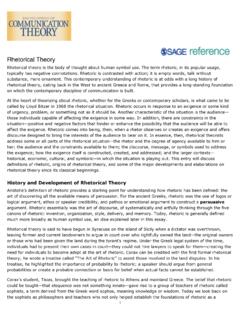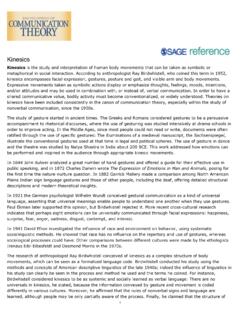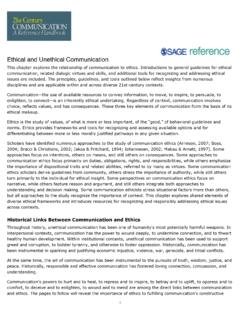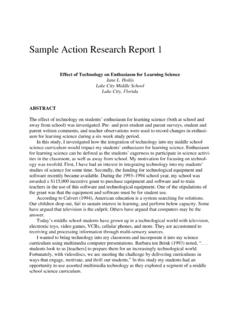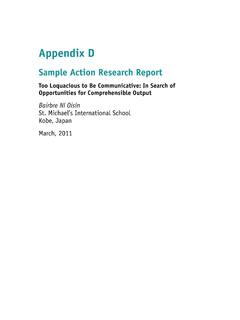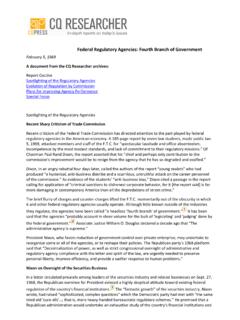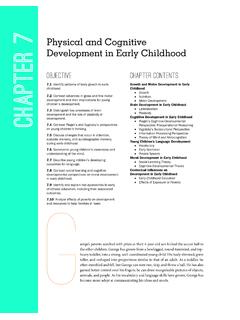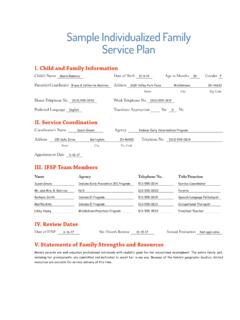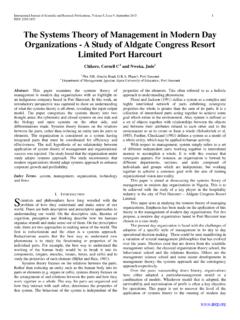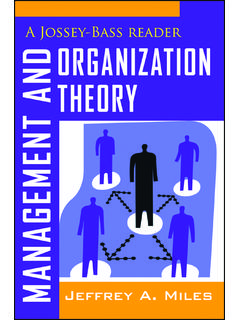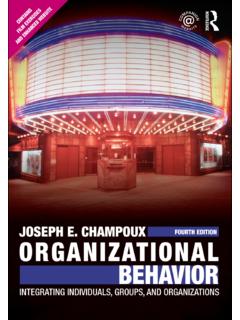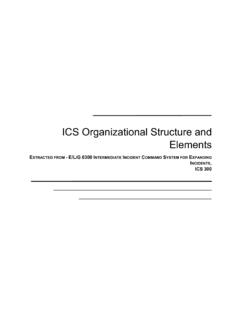Transcription of Organizational Control Theory - SAGE Publications Inc
1 Organizational Control TheoryTheories of Organizational Control examine the process by which one party attempts to influence the behavior ofanother within a given system. Organizational Control is an inherently communicative activity that consists ofverbal and physical actions designed to overcome resistance and exercise authority over others. Supervisorsmight rely upon verbal commands ( , telling someone exactly what to do), written directives ( , givingworkers a set of rules to follow), or even peer pressure ( , coworkers reinforce the importance of followingorganizational norms) to Control the actions of their subordinates. Collective effort ( , organizing) cannot beaccomplished without individuals relinquishing some degree of autonomy in order to work toward a commonobjective.
2 Communication scholars study Organizational Control processes to understand the strategies andresources Organizational leaders draw upon to convince their members to work the Organizational Control process is the fact that managers and workers often have competinginterests. Managers typically want to maximize the productivity of their subordinates in exchange for the lowestorganizational cost. In contrast, workers may seek out ways to maximize their individual compensation whileexerting the least amount of personal effort. As superior and subordinate members negotiate for their particularinterests, they create, reproduce, and transform the Organizational context in which they understand the strengths and weaknesses of various Organizational Control strategies, it is important to firstestablish a framework for examining this topic from a communication perspective.
3 Second, three approaches tothe study of Organizational Control will be examined to illustrate how different scholars make sense of thisprocess. Finally, five different management strategies will be compared against each other to illustrate theevolution of Organizational Control practices over Double Interact of ControlPhillip Tompkins and George Cheney provide a three-part framework for examining Organizational Control from acommunication perspective, which they term the double interact of Control . The first two steps of this controlprocess are based on the basic interaction model of communication often taught in introductory courses: (1) Asends a message to B; (2) B provides feedback to A.
4 Tompkins and Cheney add a third step to this model tocreate a double-interact sequence. The first part of the double interact of Control is described as the directionstep: (1) A (the Organizational leader) gives an instruction or direction to B (the subordinate). The second stepin this exchange is called evaluation: (2) A examines B's feedback to the initial message in order to determinehow the direction was interpreted. The final part of this process is the discipline step: (3) A provides B with anincentive for complying with the initial direction. If B has responded appropriately, he or she might receive somesort of reward. However, if B has performed in an unsatisfactory manner, A will provide some sort ofpunishment in an attempt to correct B's significance of the double-interact model is that it places communication central to the process ofestablishing and maintaining a system of Organizational Control .
5 This model provides scholars with a frameworkthey can use to examine and identify specific communication strategies used during particular steps of theorganizational Control to the Study of Organizational ControlOrganizational Control is a broad and interdisciplinary research area. However, there are three distinct lines ofscholarship that have had a particularly significant influence on communication Versus Structural ControlEconomist Richard Edwards describes two different approaches to Organizational Control : simple Control andstructural Control . Simple- Control strategies require the intervention of a person to direct member behavior andmaintain order in the system ( , a crew boss). In contrast, structural Control strategies move the controlprocess out of the hands of individual supervisors and into the physical or discursive environment of theorganization itself ( , machines, rule systems).
6 Edwards' two categories differentiate between interpersonaland mediated strategies of managerial influence. Simple Control provides members with a clear source ofauthority to respond to and react against. However, structural forms of Control depersonalize the managerialprocess and embed authority into the system itself. Structural Control complicates member resistance effortsbecause there is no clear source of authority for workers to communicate with or to Versus Rational ControlManagement scholars Stephen Barley and Gideon Kunda offer a slightly different approach to the study oforganizational Control . They categorize management strategies as either normative or rational. Normative- Control processes motivate and influence member behavior by encouraging the development of strong personalrelationships within the work environment.
7 Organizational leaders use the communal and social aspects of theorganization to persuade their subordinates to adopt attitudes and behaviors supportive of managerialobjectives ( , happy workers are productive workers). In contrast, rational- Control strategies influencemember behavior by providing workers with well-designed tasks, clear objectives, and reasonable incentives( , a carefully trained worker is a productive worker). In a rational- Control system, order is maintained and collective effort achieved when members understand their roles in the larger system and/or lack the resourcesnecessary to effectively resist managerial objectives. Barley and Kunda's approach highlights ways that varioussocial and task communication strategies can serve as sources of power within the Organizational Versus Unobtrusive ControlCommunication scholars Tompkins and Cheney differentiate between obtrusive and unobtrusive organizationalcontrol strategies.
8 They argue that obtrusive strategies rely upon external sources of influence to direct memberbehavior and accomplish Organizational objectives ( , rule systems, machinery, supervisors). These controlstrategies are imposed upon the individual from the external environment. Obtrusive-management techniquesdo not presume Organizational subordinates are willing or active participants in the Control process. In contrast,unobtrusive- Control strategies require Organizational members to play an active rather than passive role in theirown management. Organizational subordinates are encouraged to forge a close bond or identification with thesystem as a whole. Unobtrusively controlled workers embrace the organization's values as their own and usethem to make organizationally appropriate decisions.
9 Tompkins and Cheney's approach to this topic highlightsthe potentially interactive nature of the Organizational Control process. Communication scholars might drawupon this perspective to examine how member identification might be used as both a mechanism oforganizational Control and a strategy of member of Organizational ControlThere are a wide variety of methods Organizational leaders might use to influence the behavior of theirmembers. The five strategies listed below are commonly referenced within the Organizational Control ControlSimple Control requires the direct intervention of an authority figure to accomplish all three aspects of the2control process. A supervisor provides the initial direction to the worker, evaluates his or her performance, andthen administers some sort of disciplinary action (reward or punishment).
10 This Control strategy relies upon thestrength of the relationship between the supervisor and the subordinate to maintain order in the system. It isalso a fairly obtrusive management strategy; the worker is not required to internalize or actively participate inthe Control process. This can be a powerful management strategy because the supervisor is directly involvedwith the entire process ( , the manager sees and hears everything). However, this system can becomecompromised if the organization becomes too large or complex to Control through line of sight management. Asa result, simple Control systems tend to work best in small ControlTechnical Control relies on the intervention of some physical device ( , machine, computer software) tosubstitute for the presence of a supervisor.
